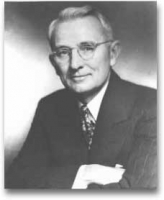阅读戴尔·卡耐基 Dale Carnegie在百家争鸣的作品!!! | |||||||
20世纪最伟大的心灵导师,美国人戴尔·卡耐基利用大量普通人不断努力取得成功的故事,通过演讲和书唤起无数陷入迷惘者的斗志,激励他们取得辉煌的成功。戴尔·卡耐基是20世纪最伟大的成功学大师,美国现代成人教育之父。卡耐基在实践的基础上撰写而成的著作,是20世纪最畅销的成功励志经典。卡耐基主要代表作有:《沟通的艺术》、《人性的弱点》、《人性的优点》、《美好的人生》、《快乐的人生》、《伟大的人物》和《人性的光辉》。这些书出版之后,立即风靡全球,先后被译成几十种文字,被誉为“人类出版史上的奇迹”。他一生致力于人性问题的研究,运用心理学和社会学知识,对人类共同的心理特点,进行探索和分折,开创并发展出一套独特的融演讲、推销、为人处世、智能开发于一体的成人教育方式。接受卡耐基的有社会各界人士,其中不乏军政要员,甚至包括几位美国总统。千千万万的人从卡耐基的教育中获益匪浅。
戴尔·卡耐基的生平简介
戴尔·卡耐基出生于1888年11月24日,逝世于1955年11月1日,享年67岁。他一生结过两次婚。他的第一任夫人,是法国的一位女伯爵, 1921年与他结婚,十年后离异。他的第二任夫人姚乐丝.卡耐基于1944年和他结婚,是他的门徒和事业的继承人,并给他生一女孩,取名丹娜。
1888年11月24日,戴尔·卡耐基诞生于密苏里州玛丽维尔附近的一个小市镇。父亲经营一个小小的农场。家里非常穷,吃不饱,穿不暖。由于营养不良,小卡耐基非常瘦小,却长着一对与头部不很相称的大耳朵。
卡耐基上的小学校名很浪漫,叫玫瑰园,却非常简陋,只有一间教室。他在学校可不是一个听话的家伙。因为调皮捣蛋,搞恶作剧,他几次差一点被学校开除。
他那双又宽又大的耳朵是同学们嘲弄的对象。有一次,班上一名叫山姆·怀特的大男孩与卡耐基发生了争吵,卡耐基说了几句很刻薄的话,怀特被激怒了,便恐吓道:“总有一天,我要剪断你那双讨厌的大耳朵。”他吓坏了,几个晚上都不敢睡觉,害怕在自己进入梦乡以后被怀特剪掉了耳朵。
当卡耐基成名以后,仍然没有忘记山姆·怀特。他归纳出了一番人生哲理:“要想别人对你友善,要想与同事和睦地相处,处理好上下级关系,那就绝不能去触动别人心灵的伤疤。”卡耐基还发现,他具有与生俱来的忧郁性格。他曾向朋友倾诉:烦恼伴随着我的一生。我一直想弄明白自己的忧虑来自何处。有一天,我帮母亲摘取樱花的种子时,突然哭泣起来。母亲问:“你为什么哭?”我边哭边答:“我担心自己会不会像这种子一样,被活活埋在泥土里。”儿时的我,担惊受怕的事情真的不少:下雷雨时,担心会不会被雷打死;年景不好时担心以后有没有食物充饥;还担心死后会不会下地狱。稍大以后更加胡思乱想:想自己的衣着、举止会不会被女孩子取笑,担心没有女孩子愿意嫁给我。但后来我发现,曾经使我非常担心的那些事情,99%都没有发生。”
一个如此没有自信,几乎被各种各样莫名其妙的忧虑缠绕的小伙子,最终成为给别人自信、让人们乐观的心理激励大师,这中间需要经历多少磨砺,就可想而知了。
卡耐基16岁时,不得不在自家的农场里干更多的活。每天早晨,他骑马进城上学。放学后便急匆匆地骑马赶回家里,挤牛奶、修剪树木、收拾残汤剩饭喂猪…… 在学校里,瘦弱、苍白的卡耐基永远穿着一件破旧而不合身的夹克,一副失魂落魄的样子。有一次上数学课时,卡耐基被老师叫到黑板前解答问题。他刚走上讲台,就听见身后爆发出一阵哄堂大笑。下课后才明白同学们笑话他的原因。班上一名捣蛋鬼坐在他背后,在他的破夹克的裂缝处插了一朵玫瑰花,还在旁边贴了一张字条,写着:“我爱你,瑞德·杰克先生。”在英语中,瑞德·杰克与破夹克是谐音词。卡耐基非常难受。回家后他对母亲说:“同学们老是笑话我穿的破衣服,我不能集中精力听课。”妈妈说道:“你为什么不想办法让他们因佩服你而尊敬你呢?不必伤心,今年秋季,我一定给你买套新衣服。”卡耐基在童年时代受到他母亲很大影响。母亲生性乐观,百折不挠。一次大水灾,洪水冲出了河堤,把农场的所有农作物冲得不见踪影。父亲用绝望的声音喊道:“上帝,你为什么老是和我过不去?我什么时候才能走出困境!”而母亲却十分镇静,她哼唱着歌,将家园重新收拾好。母亲对卡耐基寄予厚望,一直鼓励他好好读书,希望他将来做一名传教士,或做一名教员。
1904年,卡耐基高中毕业后就读于密苏里州华伦斯堡州立师范学院。这时,家里已把农场卖掉,迁到学院附近。卡耐基负担不起市镇上的生活费用,就住在家里,每天骑马到学校去上课。他是全校600名学生中五六个住不起市镇的学生之一。他虽然得到全额奖学金,但还必须四处打工,以弥补学费的不足。
卡耐基发现,学院辩论会及演说赛非常吸引人,优胜者的名字不但广为人知,而且还被视为学院的英雄人物。这是一个成名和成功的最好机会。
但他没有演说的天赋,参加了12次比赛,屡战屡败。三十年后,卡耐基谈及第一次演说失败时,还以半开玩笑的口吻说:“是的,虽然我没有找出旧猎枪和与之相类似的致命东西来,但当时我的确想到过自杀…… 我那时才认识到自己是很差劲的……”经历失败后,卡耐基发奋振作,重新挑战自我。
1906年,戴尔·卡耐基一篇以《童年的记忆》为题的演说,获得了勒伯第青年演说家奖。这是他第一次成功尝试,这份讲稿至今还存在瓦伦斯堡州立师范学院的校志里。这次获胜,对他的一生产生了非同小可的影响。
他在后来的回忆中不无自豪地说:“我虽然经历了12次失败,但最后终于赢得了辩论比赛。更为激励我的是,我训练出来的男学生赢了公众演说赛。女学生也获得了朗读比赛的冠军。从那一天起,我就知道我该走怎样的路了……”1908年,卡耐基仍旧很贫穷,但与两年前进入师范学院时已有天壤之别了。他成了全院的风云人物,在各种场合的演讲赛中大出风头。全院的师生对他刮目相看;但他并不满足于此,他开始走出学院去扩大自己演讲的影响了。
他原先的目标,是想在学校里获得学位,毕业后回到家乡的学校里去教书。但在快毕业的那年里,他发现同班的一个同学在暑假为国际函授学校推销函授课,每周所得的钱,比他父亲的辛勤所得还高出四倍。因此,他在1908年毕业后,便赶到国际函授学校总部所在地的丹佛市,受雇做了一名推销员,后来他又到南奥马哈,为阿摩尔公司贩卖火腿,肥皂和猪油。他的这个推销工作虽然很成功,但在1911年,他却到纽约《美国戏剧艺术学院》学习演戏。一年以后,他感到自己并不具备演戏的天才,于是又回到推销的行业里,为一家汽车公司当推销员。
但这些工作都不合他的理想。他为没有实现在大学里梦想生活,这比赚钱更重要。他决心白天写书,晚间去夜校教书,以赚取生活费。他想为夜校教公开演讲课,因为他认为,大学时代他在公开演说方面受过训练,有所经验。这些训练和经验,扫除了他的怯懦和自卑,让他有勇气和信心跟人打交道,增长了做人处世的才能。于是他说服了纽约一个基督教青年会的会长,同意他晚间为商业界人士开设一个公开演讲班。从此,他开始了为之奋斗一生的成人教育事业。
戴尔·卡耐基的代表著作
《语言的突破》 (出版于1931年)
《人性的光辉》 (出版于1932年)
《人性的弱点》 (出版于1936年)
《美好的人生》 (出版于1936年)
《伟大的人物》 (出版于1943年)
《人性的优点》 (出版于1948年)
《快乐的人生》 (出版于1948年)
One of the core ideas in his books is that it is possible to change other people's behavior by changing one's reaction to them.
Biography
Born in 1888 in Maryville, Missouri, Carnegie was a poor farmer's boy, the second son of James William Carnagey (b. Indiana, February 1852 – living 1910) and wife Amanda Elizabeth Harbison (b. Missouri, February 1858 – living 1910). In his teens, though still having to get up at 4 a.m. every day to milk his parents' cows, he managed to obtain an education at the State Teacher's College in Warrensburg. His first job after college was selling correspondence courses to ranchers; then he moved on to selling bacon, soap and lard for Armour & Company. He was successful to the point of making his sales territory of South Omaha, Nebraska, the national leader for the firm.
After saving $500, Dale Carnegie quit sales in 1911 in order to pursue a lifelong dream of becoming a Chautauqua lecturer. He ended up instead attending the American Academy of Dramatic Arts in New York, but found little success as an actor, though it is written that he played the role of Dr. Hartley in a road show of Polly of the Circus.
When the production ended, he returned to New York, unemployed, nearly broke, and living at the YMCA on 125th Street. It was there that he got the idea to teach public speaking, and he persuaded the "Y" manager to allow him to instruct a class in return for 80% of the net proceeds. In his first session, he had run out of material; improvising, he suggested that students speak about "something that made them angry", and discovered that the technique made speakers unafraid to address a public audience. From this 1912 debut, the Dale Carnegie Course evolved. Carnegie had tapped into the average American's desire to have more self-confidence, and by 1914, he was earning $500 - the equivalent of nearly $10,000 now - every week.
Perhaps one of Carnegie’s most successful marketing moves was to change the spelling of his last name from “Carnagey” to Carnegie, at a time when Andrew Carnegie (unrelated) was a widely revered and recognized name. By 1916, Dale was able to rent Carnegie Hall itself for a lecture to a packed house. Carnegie's first collection of his writings was Public Speaking: a Practical Course for Business Men (1926), later entitled Public Speaking and Influencing Men in Business (1932). His crowning achievement, however, was when Simon & Schuster published How to Win Friends and Influence People. The book was a bestseller from its debut in 1936, in its 17th printing within a few months. By the time of Carnegie's death, the book had sold five million copies in 31 languages, and there had been 450,000 graduates of his Dale Carnegie Institute. It has been stated in the book that he had critiqued over 150,000 speeches in his participation in the adult education movement of the time. During World War I he served in the U.S. Army.
His first marriage ended in divorce in 1931. On November 5, 1944, in Tulsa, Oklahoma, he married Dorothy Price Vanderpool, who also had been divorced. Vanderpool had two daughters; Rosemary, from her first marriage, and Donna Dale from their marriage together.
Carnegie died at his home in Forest Hills, New York. He was buried in the Belton, Cass County, Missouri, cemetery. The official biography from Dale Carnegie & Associates, Inc. states that he died of Hodgkin's disease on November 1, 1955.
The Dale Carnegie Course
The Dale Carnegie Course is a program for businesses based on Carnegie's teachings used worldwide. It was founded in 1912 and is represented in more than 80 countries. More than 8 million people have completed Dale Carnegie Training.
The course comprises a proprietary process that uses team dynamics and intra-group activities to strengthen interpersonal relations, manage stress and handle fast-changing workplace conditions. Other subjects included are communication, creative problem-solving and focused leadership.
The course is based on a five-phase continuous improvement cycle:
1. Build Greater Self-Confidence
2. Strengthen People Skill
3. Enhance Communication Skill
4. Develop Leadership Skill
5. Improve Our Attitude
Book
* 1913: Public Speaking and Influencing Men In Business. An introduction to public speaking.
* 1932: Lincoln the Unknown. A biography of Abraham Lincoln.
* 1936: How to Win Friends and Influence People. A self-help book about interpersonal relations and how to succeed.
* 1946: Five Minute Biographie
* 1944: How to Stop Worrying and Start Living. A self-help book about stress management.
Footnote
1. ^ How To Win Friends And Influence People, by Dale Carnegie, Introduction by Lowell Thomas, p. 9, copyright 1964.
2. ^ Current biography 1941, pp. 138-40.
3. ^ a b Id.
4. ^ http://www.dalecarnegie.com/about_us/history.jsp
5. ^ TIME Magazine, November 14, 1955.
6. ^ How To Win Friends And Influence People, by Dale Carnegie, Introduction by Lowell Thomas, p. 6, copyright 1960.
7. ^ http://www.nytimes.com/learning/general/onthisday/bday/1124.html
8. ^ Staff. "JOSEPHINE CARNEGIE WED; She Becomes Bride of Gerard B. Nolan at Forest Hills", The New York Times, May 30, 1937. Accessed June 18, 2009. "The ceremony was performed by the Rev. J. P. Holland at the home of the bride's uncle, Dale Carnegie, author, in Forest Hills, Queens."
9. ^ Shelokhonov, Steve. Biography for Dale Carnegie at imdb.com
10. ^ http://www.dalecarnegie.com/about_us/history.jsp
